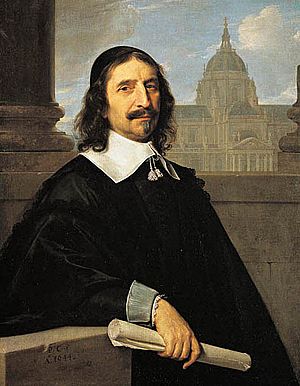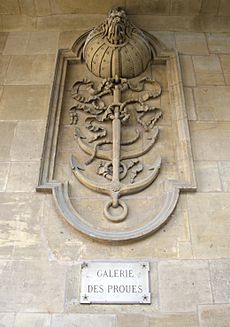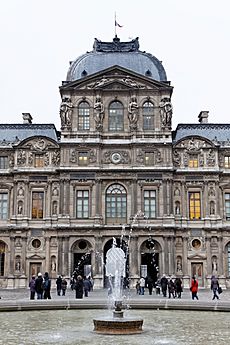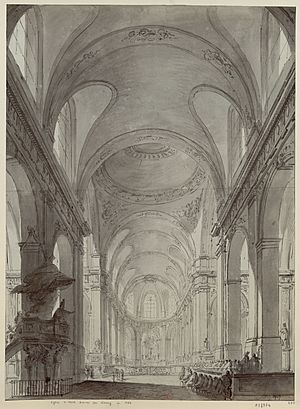Jacques Lemercier facts for kids
Quick facts for kids
Jacques Lemercier
|
|
|---|---|

Jacques Lemercier in 1644 by Philippe de Champaigne with the Sorbonne Chapel in the background
|
|
| Born | c. 1585 Pontoise, France
|
| Died | 13 January 1654 Paris, France
|
| Nationality | French |
| Occupation | Architect |
| Buildings |
|
Jacques Lemercier (born around 1585 in Pontoise – died January 13, 1654, in Paris) was a famous French architect and engineer. He was one of three very important architects, along with Louis Le Vau and François Mansart. Together, they created a new style of French architecture called French Baroque. This style mixed older French designs with new ideas from Rome. It became very popular during the time of Cardinal Richelieu and King Louis XIII.
Jacques Lemercier's Life and Work
Jacques Lemercier was born in Pontoise, France. His father, Nicolas Lemercier, was a master stone carver. Jacques came from a family of skilled builders.
He traveled to Italy and spent a long time in Rome, probably from about 1607 to 1610. This trip helped him learn about new building styles. He then developed a simpler, more classical way of designing buildings. This style was similar to what Salomon de Brosse used, who designed the Palais du Luxembourg. Lemercier even helped finish the Palais du Luxembourg after Brosse died.
After returning to France, Lemercier worked for several years as an engineer, building bridges. His first big project was finishing the Church of the Oratorians in Paris in 1616. This church was started by Clément Métezeau. Its success made Lemercier very well known.
By 1618, he became an "architecte du roy," which means "architect to the king." In 1625, Cardinal Richelieu put him in charge of a huge royal project: adding new parts to the Louvre palace. Lemercier followed the original design by Pierre Lescot. He built the northern part of the west side and the famous Pavillon de l'Horloge (Clock Pavilion) in the middle of the west wing. This pavilion has a tall, square dome that stands out from the roof. It also has three arched openings that lead to the courtyard.
From 1638 to 1639, Lemercier became the "premier architecte," or "first architect," in charge of all royal building projects. During this time, he had a disagreement with the artist Nicolas Poussin about decorations in the Louvre.
Among the private mansions he designed in Paris, the Hôtel de Liancourt (built in 1623) is a notable example.

Lemercier also built Cardinal Richelieu's home in Paris, starting in 1627. This palace is known today as the Palais Royal. Most of Richelieu's palace was destroyed by fire in 1763. Only one small part remains: a wall with carvings of ship anchors and prows. These carvings showed Richelieu's important role as the head of the navy.
Lemercier also worked on a much bigger project. He designed an entire new town called Richelieu in Poitou. This included a grand palace, a large church, and the whole town layout. The Château de Richelieu (Richelieu Castle) itself is now gone. He also rebuilt the Château de Rueil for the Cardinal, which was also later torn down. However, the Château of Thouars, with its impressive long front, still stands today.
Lemercier also designed beautiful parterre gardens. These formal gardens were laid out at Montjeu, Richelieu, and Rueil.

One of Lemercier's most famous surviving works is the domed church at the Sorbonne (built in 1635). This church has a round dome on a tall, eight-sided base. It was the first dome of its kind in France. The church has two levels of columns on the front. Inside, the main area is surrounded by rounded ceilings. Cardinal Richelieu was buried in this church in 1642.
At the royal abbey church of Val-de-Grâce, Lemercier took over from François Mansart. Mansart had built the church up to the roofline but left the project. Lemercier finished it by adding the dome.
King Louis XIII asked Lemercier to help plan an expansion of the hunting lodge at Versailles. However, this huge project was later completed by other architects, like Louis Le Vau and Jules Hardouin-Mansart, under King Louis XIV.
One of Lemercier's last projects was designing the Church of Saint-Roch in Paris. King Louis XIV laid the first stone in 1653. This church is one of the largest in Paris, measuring 126 meters long. Lemercier completed the main altar area and the central part of the church. The rest of the inside was built following his plans.
Even after a long career, Lemercier did not become rich. In 1645, as the "first architect to the King," he earned a good salary. But after he died in the house he built for himself in Paris, his large collection of books had to be sold to pay off his debts.
Jacques Lemercier died in Paris in 1654. Louis Le Vau took his place as the first royal architect.
See also
 In Spanish: Jacques Lemercier para niños
In Spanish: Jacques Lemercier para niños
- Salomon de Brosse
- Liberal Bruant
- Pierre Le Muet
- Louis Le Vau
- François Mansart
- Clément Métezeau



